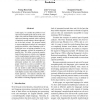Free Online Productivity Tools
i2Speak
i2Symbol
i2OCR
iTex2Img
iWeb2Print
iWeb2Shot
i2Type
iPdf2Split
iPdf2Merge
i2Bopomofo
i2Arabic
i2Style
i2Image
i2PDF
iLatex2Rtf
Sci2ools
EMNLP
2011
2011
Universal Morphological Analysis using Structured Nearest Neighbor Prediction
In this paper, we consider the problem of unsupervised morphological analysis from a new angle. Past work has endeavored to design unsupervised learning methods which explicitly or implicitly encode inductive biases appropriate to the task at hand. We propose instead to treat morphological analysis as a structured prediction problem, where languages with labeled data serve as training examples for unlabeled languages, without the assumption of parallel data. We define a universal morphological feature space in which every language and its morphological analysis reside. We develop a novel structured nearest neighbor prediction method which seeks to find the morphological analysis for each unlabeled language which lies as close as possible in the feature space to a training language. We apply our model to eight inflecting languages, and induce nominal morphology with substantially higher accuracy than a traditional, MDLbased approach. Our analysis indicates that accuracy continues to...
EMNLP 2011 | Morphological Analysis | Morphological Feature | Natural Language Processing | Prediction Problem |
| Added | 20 Dec 2011 |
| Updated | 20 Dec 2011 |
| Type | Journal |
| Year | 2011 |
| Where | EMNLP |
| Authors | Young-Bum Kim, João Graça, Benjamin Snyder |
Comments (0)

